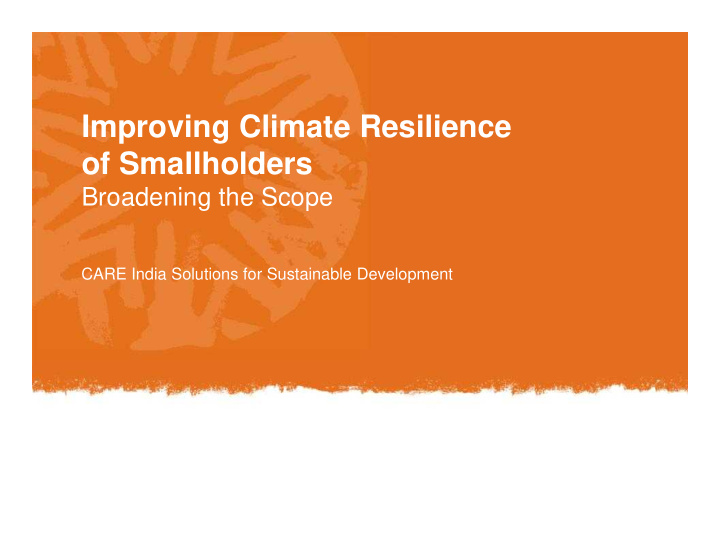



Improving Climate Resilience of Smallholders Broadening the Scope CARE India Solutions for Sustainable Development
CSA: Practices and Methods Integrated practices: agroforestry, livestock & agriculture Integrated practices: agroforestry, livestock & agriculture Crop production: varietal selection, plant breeding, conservation agriculture Crop production: varietal selection, plant breeding, conservation agriculture Livestock and supply chain management: feed, manure management Livestock and supply chain management: feed, manure management Forestry: goods & services essential for livelihoods Forestry: goods & services essential for livelihoods Energy: recution of dependency on non-renewable energy Energy: recution of dependency on non-renewable energy Water and land management: landscape management, efficient use of rersources Water and land management: landscape management, efficient use of rersources Fisheries and Aquaculture Fisheries and Aquaculture Genetic resources & biodiversity: diversity of species, within species, of ecosystems Genetic resources & biodiversity: diversity of species, within species, of ecosystems Nuclear techniques: increase of productivity, resilience of systems, reduce GHG Nuclear techniques: increase of productivity, resilience of systems, reduce GHG 1 December 19, 2016
Action on the ground Repaired dhodhi Water structure Inter-cropping Pitcher-irrigation Agro-forestry Bio-fertilizer preparation Exposure to other 2 Market visits for women groups December 19, 2016
Broadening the Scope Climate Vulnerability and Capacity Analysis • Analysis of vulnerability to climate change and adaptive capacity at the community level • Combine community knowledge and scientific data to yield greater understanding about local impacts of climate change • Gendered response to and impacts of climate change • Lack of voice to assert rights and entitlements • Sustainability of infrastructure focused interventions • Need to build on strengths • Calibrating preparedness and response • Building a sense of purpose and accountability 3 December 19, 2016
Tools and Approaches for Community Based Adaptation Adaptive Capacity is the ability of a system to adjust to climate change (including climate variability and extremes) to moderate potential damages, to take advantage of opportunities, or to cope with the consequences • Participatory planning with women at the centre Community Adaptation Plans • Village Development Committees for decision making • Index capturing Asset base, Knowledge and Information, Adaptive Capacity Index Institutions and Entitlements, Decision making and Governance, Innovation • Purposive selection of SHG platforms SHG Quality Assessment and Gender Tools in CC • Inclusion, WASH, Social Action indicators Context • Gender Tools and REFLECT Circles • Evolving technical package together – improving water Farmer Field Schools storage and supply infrastructure, agri-input, technology and practices; water audits • Local understanding of scenarios and responses Integrating Local Knowledge, Structures and • Reviving local water bodies, including dhodis used by Institutions women; promoting exchange of local seed varieties 4 December 19, 2016
What are we learning? • Integration of social equity and gender equality – Who is the most vulnerable? • Building adaptive capacities – an iterative process requiring work along the Resilience Spectrum • Importance of engagement and ownership – Who owns the process and products? • Community level vulnerabilities vis-à-vis HH and individual level disasters – streamlining planning at multiple levels • Limits to or frontiers of progress – investing in women’s literacy and leadership • Sustaining water infrastructure development – Leveraging user investments, community institutions, and schematic links • Sensitization through visibilization for improved accountability – Of duty bearers and service providers Sustainable, Productive, Equitable and Resilient SuPER Livelihoods, Food and Nutrition Security 5 December 19, 2016
Thank you!
Recommend
More recommend